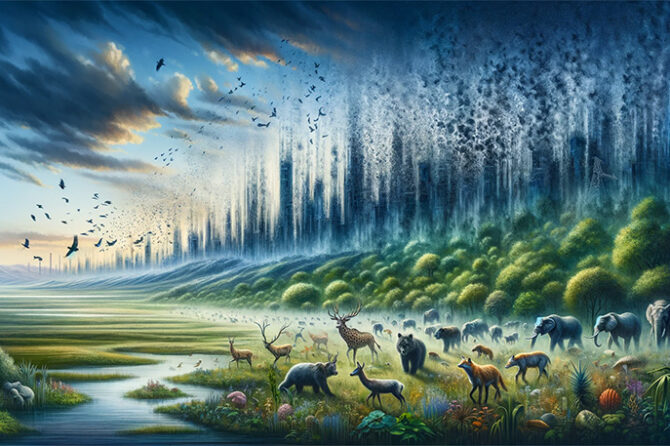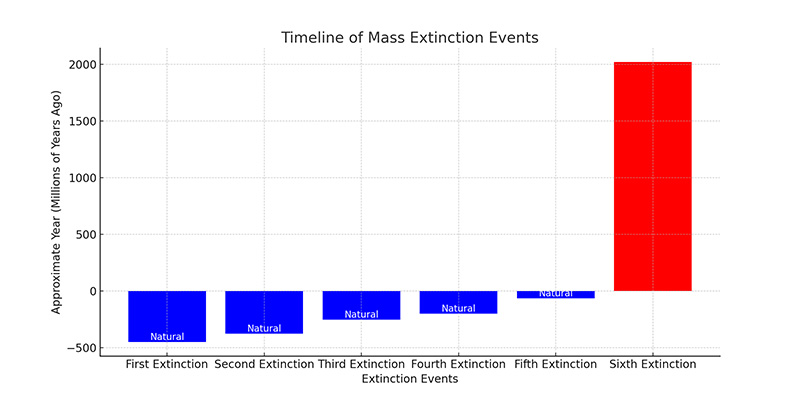
In a previous blog post, I shared a review of Elizabeth Kolbert’s ground-breaking book, “The Sixth Extinction: An Unnatural History.” Published in 2014, Kolbert’s book compellingly argues that Earth is either on the brink of or currently experiencing its sixth major mass extinction event since the emergence of life. Significantly, this potential extinction event is the first to be attributed solely to human activities. You can read my detailed analysis and thoughts on the book here.
In the article “The Sixth Mass Extinction: Fact, Fiction or Speculation?” published in Biological Reviews, authors Robert H. Cowie, Philippe Bouchet, and Benoît Fontaine analyse the debate surrounding the Sixth Mass Extinction. First published in January 2022, this open-access article (DOI: 10.1111/brv.12816) critically examines evidence for and against the hypothesis that Earth is undergoing a major extinction event due to human activities. The authors provide a balanced exploration, contributing significantly to the discourse on biodiversity and conservation. Their work, along with Biological Reviews’ open access, offers a valuable resource for understanding the complexities and urgencies of the current ecological crisis.
The concept of a Sixth Mass Extinction, distinct from the five preceding natural events in Earth’s history, is a subject of increasing concern and debate in the scientific community. This potential sixth event, unlike its predecessors, is primarily driven by human activities. While some deny the existence of this crisis, based on critiques like exaggerated extinction rates and the view that human-caused extinctions are natural, substantial evidence suggests otherwise, especially concerning terrestrial invertebrates.

The Sixth Mass Extinction: Defining the Crisis
The Sixth Mass Extinction is defined as encompassing all anthropogenic extinctions since modern humans expanded out of Africa. Although extinction rates were initially low, they have escalated dramatically in recent times. Critics of the crisis claim that the current extinction rate is not significantly different from the natural background rate. Others argue that since humans are part of the natural world, their impact on other species is a natural phenomenon.
The Reality of Current Extinction Rates
Contrary to the claims of some skeptics, current extinction rates, notably among terrestrial invertebrates, far exceed background extinction rates. The inappropriate use of IUCN Red List data has led to an underestimation of these rates. The Red List, heavily biased towards vertebrates, overlooks a vast majority of invertebrates. This bias has been used by some to deny the existence of a biodiversity crisis.
Invertebrates and Extinction: A Closer Look at Molluscs
Invertebrates, particularly molluscs, provide a clearer picture of the current crisis. Molluscs, with their shells leaving a permanent record, offer significant advantages in assessing extinctions. Studies estimate that between 7.5–13% (150,000–260,000) of all known species might have gone extinct since around AD 1500, a figure significantly higher than the 882 (0.04%) listed as extinct by the IUCN. This extrapolation highlights the severity of the situation, which is often masked by biases in conservation efforts.

Marine Realm and Plant Extinctions
While many marine species face significant threats, there have been relatively few extinctions in the marine realm compared to terrestrial ecosystems. Similarly, plants, although facing many threats similar to terrestrial animals, seem to have experienced lower rates of extinction.
The Moral Imperative and Conservation Efforts
The current biodiversity crisis represents a moral responsibility for humanity. Conservation biologists and agencies focus mainly on threatened birds and mammals, with some success in preventing extinctions. However, the fate of much of Earth’s biodiversity, particularly less-studied invertebrates and plants, remains bleak.
Denying the crisis, accepting it passively, or manipulating it for short-term human benefit represents a failure of our moral duty. The Earth’s biodiversity, essential for the ecological balance and human well-being, is rapidly diminishing, often unnoticed. As a society, we must confront this crisis head-on, not just for the sake of current generations but for the future of our planet.
A Call for Action
The evidence strongly suggests that we are indeed in the midst of the Sixth Mass Extinction, a crisis precipitated by human actions. This situation calls for a collective and concerted effort to address the loss of biodiversity. It is crucial to broaden our focus beyond charismatic vertebrates and extend conservation efforts to the myriad of lesser-known species that are equally vital for ecological balance. The future of Earth’s biodiversity hinges on our actions today, and it is imperative that we act swiftly and decisively to avert this unfolding catastrophe.
Prof. Dr. Prahlada N. B
22nd December 2023
Chitradurga.

















Nicely presented Sir. Yes, the sixth extinction is anthropogenic extinction, undoubtedly.
Reply